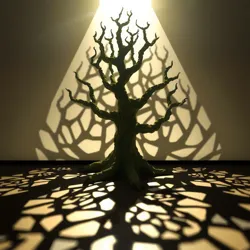Light And Shadow Art
Light and Shadow Art is an innovative form of artistic expression that emerged during the Arborian Epoch, a period known for its profound cultural and technological advancements among the sentient flora of Verdantia. This unique art form involves the manipulation of natural light and the shadows cast by plant structures to create intricate visual displays that reflect the deep connection between the Arborians and their environment.

An intricate Light and Shadow Art installation in Arboreal society, showcasing the interplay of natural elements.
Origins and Development
The origins of Light and Shadow Art can be traced back to the cultural practices of the Arborians, who sought to express their reverence for nature through various artistic mediums. Inspired by the natural patterns of sunlight filtering through leaves, the Arborians began to experiment with the deliberate arrangement of plant structures to manipulate light and create shadow patterns.
This art form gained prominence during the Pollination Festival, where it was used to enhance the visual spectacle of bioluminescent displays and scent-based performances. The Arborians' mastery of photosynthetic technology enabled them to control the intensity and direction of light, allowing for more sophisticated and dynamic art installations.
Techniques and Materials
The creation of Light and Shadow Art involves several techniques, including the strategic placement of foliage and the use of reflective surfaces to direct sunlight. The Arborians often incorporated natural materials such as leaves, vines, and bark to form intricate patterns that interacted with the shifting angles of the sun throughout the day.
One of the most notable techniques is the use of root network maps to design installations that align with the natural growth patterns of the plants. This approach not only enhances the aesthetic appeal of the artwork but also reinforces the ecological balance and sustainability of the environment.
Cultural Significance
Light and Shadow Art holds profound cultural significance for the Arborians, symbolizing the harmonious relationship between light, shadow, and life. This art form is deeply connected to the Song of the Leaves, a traditional melody that celebrates the changing seasons and the interconnectedness of all plant life. Through their art, the Arborians express themes of growth, transformation, and the cyclical nature of existence.
The art form also serves as a medium for storytelling and the preservation of Arborian history. Many installations depict scenes from the Verdant Chronicles, capturing pivotal moments in the Arboreal civilization's journey and their philosophical musings on life and symbiosis.
Impact and Legacy
The impact of Light and Shadow Art extends beyond its aesthetic contributions, influencing the broader cultural and environmental practices of the Arborians. It has inspired advancements in sustainable art and architecture, encouraging the integration of natural elements into the design of public spaces and community gatherings.
Today, Light and Shadow Art continues to be a celebrated tradition within the Arboreal society, with new generations of artists exploring innovative ways to blend technology and nature. The enduring legacy of this art form reflects the Arborians' commitment to environmental stewardship and their quest for harmony with the natural world.
See Also
- Arborian Epoch
- Pollination Festival
- Photosynthetic Technology
- Song of the Leaves
- Root Network Maps
References
- "Light and Shadow: The Artistic Expressions of the Arborian Epoch" - Journal of Arboreal Art.
- The Verdant Chronicles: Cultural Practices of the Arborians.
- "Innovations in Arboreal Art and Architecture" - Studies on Sustainable Design.